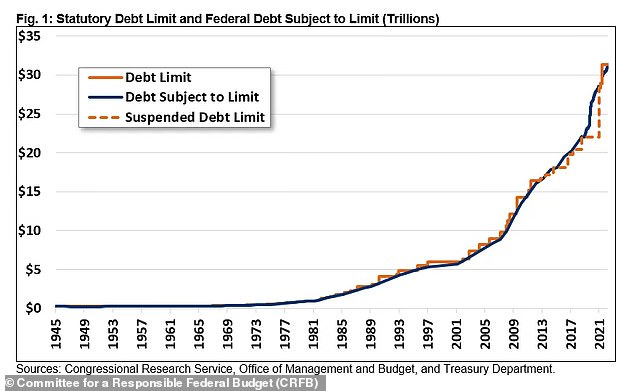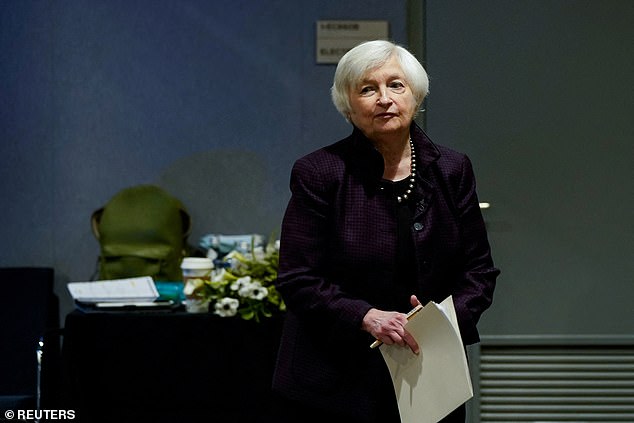US to Hit Debt Limit as Treasury Secretary Janet Yellen Prepares “Extraordinary Measures”
>
The United States is expected to hit a peak on Thursday, forcing the Treasury Department to start using “extraordinary measures” so the government can keep paying the bills while Congress negotiates to try to avoid an economic collapse.
US debt now stands at $31.38 trillion, which is 120 percent of GDP, up from 39.2 percent in 2008 and 77.6 percent in 2018.
The staggering figure is the highest since World War II, equals $246,876 in federal debt per taxpayer and is more than the economies of China, Japan, Germany and the United Kingdom combined.
“Extraordinary measures” refer to accounting solutions to ensure financial liquidity to keep the government open at least until June, according to a letter sent by Treasury Secretary Yellen to President Kevin McCarthy on January 13.
First, the government will temporarily suspend payments to retirement, disability, and health benefit funds for federal employees. Second, it will suspend the reinvestment of maturing government bonds in the retirement savings accounts of government workers.
Nearly 25 million full-time and part-time employees or about 12 percent of the American workforce will be affected if the debt meltdown goes into default in June.
The largest and most immediate impact is economic uncertainty in financial markets, including Americans’ 401(k) retirement accounts, which continue to take a significant toll from the global pandemic, and economic uncertainty due to Russia’s war on Ukraine.
Wall Street fell lower on Thursday extending its biggest one-day drop of the year into Wednesday after new economic data raised concerns about the possibility of a recession.
The White House went on the offensive Wednesday.
“They’re threatening to kill millions of jobs and 401K plans by trying to hold the debt limit hostage unless they can cut Social Security, cut Medicare, cut Medicaid,” press secretary Karine Jean-Pierre said during her speech. regular briefing.
If an agreement is not reached before the summer, the consequences could lead to a global economic crisis. Since 1960, Congress has raised, extended or revised the debt limit 78 times when the United States reached its debt ceiling.
Going forward, President Joe Biden and Congress will negotiate to reach an agreement that raises the national debt ceiling, which is reduced to $94,213 per citizen, according to the Senate Budget Committee.
Republicans have said they will oppose raising the debt ceiling without cutting federal spending, while the White House and Democrats refuse to allow the GOP to cut federal programs like Social Security.
The United States is expected to hit a peak on Thursday, forcing the Treasury Department to start using “extraordinary measures” so the government can keep paying the bills while Congress negotiates to try to avoid an economic collapse.

The federal debt ceiling was raised in December 2021 by $2.5 trillion to $31.381 trillion, which is expected to be reached on Thursday, January 18.
These indigestion-inducing, nail-biting talks aren’t expected to be resolved until just before a potentially catastrophic economic collapse, but there have been roughly 80 deals to raise or suspend the borrowing limit since the 1960s.
So far, House Speaker Kevin McCarthy and Biden are playing what could be a dangerous game of chicken with the world’s largest economy in the middle.
The results could be devastating for both taxpayers and the global economy, so DailyMail.com has broken down what to expect when both sides enter the ring and try to work out détente.
WHAT ARE ‘EXTRAORDINARY MEASURES’?
Yellen listed two measures that will begin this month to prevent the government from defaulting.
First, the government will temporarily suspend payments to retirement, disability, and health benefit funds for federal employees. Second, it will suspend the reinvestment of maturing government bonds in the retirement savings accounts of government workers.
By suspending payments, the government can reduce the amount of outstanding debt. That allows the Treasury Department to continue funding government operations, according to Yellen’s letter.

Treasury Secretary Janet Yellen will have to resort to “extraordinary measures” to maintain government solvency after the US hits the debt ceiling, scheduled for Thursday.
WHAT ALLOWS TREASURY TO DO THIS?
Congress has given the Treasury the authority to do so.
Because these are retirement accounts, no one is hurt by the government equivalent of a promissory note.
Funding is completed after an increase or suspension of the debt ceiling is signed into law. It’s not necessarily the measures that can hurt the economy, but doubts among consumers and businesses about whether lawmakers will raise the borrowing limit.
WHAT CAN $1 BILLION BUY?
A billion here and a billion there, it starts to add up, but what can you buy for $1 trillion dollars anyway?
- Coffee with milk at $3 a day for the next 900 million years
- Australia’s GDP, according to The World Bank
- Fund the armed forces of the 30 NATO countries
- The combined wealth of the nine richest people in the world, including Bernard Arnault, Elon Musk, Gautam Adani, Bill Gates, Jeff Bezos, Warren Buffett, Larry Elison, Mukesh Ambani, and Steve Ballmer. according to Investopedia
HOW COMMON IS THIS?
“Treasury Secretaries of all Administrations over the past decades have used these extraordinary measures when necessary,” Yellen wrote in her letter.
The measures were first implemented in 1985 and have been used at least 16 times since then, according to the Committee for a Responsible Federal Budget, a fiscal watchdog.
Treasury last took “extraordinary measures” in late 2021 to prevent default. Lawmakers were finally able to reach an agreement and raise the debt limit.
WHY DO WE HAVE A DEBT LIMIT?
Before World War I, Congress needed to approve every bond issue. The debt limit was created as a way to finance the war effort without the need for a constant series of votes.
Since then, a tool created to make government work easier has become a source of dysfunction, stoking partisan warfare and creating economic risk as debt has grown in size over the past 20 years.
HOW RISKY IS BRINKMANSHIP?
There is palpable concern about how Biden, McCarthy and the Democratic Senate will find common ground.
A default could cause millions of jobs to be lost, a deep recession that would reverberate globally, and ironically, higher interest rates that would make it harder to manage federal debt.
McCarthy said Tuesday that talks should begin immediately about possible spending cuts Republicans are seeking in exchange for raising the debt limit, even though the Biden administration has equated that demand with holding the US economy hostage. .
‘Who wants to put the nation in some sort of last-minute threat of the debt ceiling?’ McCarthy said. ‘Nobody wants to do that. That’s why we’re asking, ‘Let’s change our behavior now. Let’s sit down.
The Biden administration wants the borrowing limit raised without preconditions. White House press secretary Karine Jean-Pierre on Tuesday ruled out any talks with McCarthy.
DO DEBT LIMIT SHOWDOWNS HELP REDUCE GOVERNMENT DEBT?
Not really.
The Congressional Budget Office estimates that annual budget deficits will increase from about $1 trillion to more than $2 trillion over the next 10 years. As the Baby Boomer generation ages out of the workforce, government programs, including Medicare and Social Security, will exceed tax revenue. That suggests the government would need severe spending cuts, big tax increases, or some combination of those options.
In 2011, when Barack Obama was president and Biden was vice president, there was a bipartisan agreement to raise the debt limit by $900 billion in exchange for $917 billion in automatic spending cuts over 10 years.
But debt reduction never fully materialized.
After Donald Trump became president in 2017, Republican lawmakers pushed further debt increases by passing deficit-funded tax cuts. Debt accelerated further with the start of the coronavirus pandemic in 2020, which prompted massive government borrowing to pull the US out of a deep recession.
The CBO estimated last year that the US debt would exceed $40 trillion by 2032.
